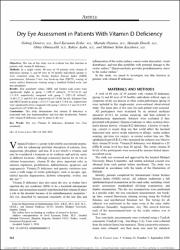| dc.contributor.author | Demirci, Göktuğ | |
| dc.contributor.author | Erdur, Sevil Karaman | |
| dc.contributor.author | Özsütçü, Mustafa | |
| dc.contributor.author | Eliaçık, Mustafa | |
| dc.contributor.author | Ölmüşçelik, Oktay | |
| dc.contributor.author | Aydın, Rukiye | |
| dc.contributor.author | Kocabora, Mehmet Selim | |
| dc.date.accessioned | 10.07.201910:49:13 | |
| dc.date.accessioned | 2019-07-10T19:50:12Z | |
| dc.date.available | 10.07.201910:49:13 | |
| dc.date.available | 2019-07-10T19:50:12Z | |
| dc.date.issued | 2018 | en_US |
| dc.identifier.citation | Demirci, G., Karaman Erdur, S., Özsütçü, M., Eliaçık, M., Ölmüşçelik, O., Aydın, R. ... Kocabora, M. S. (2018). Dry eye assessment in patients with vitamin D deficiency. Eye and Contact Lens, 44(Supplement: 1), S62-S65. https://dx.doi.org/10.1097/ICL.0000000000000325 | en_US |
| dc.identifier.issn | 1542-2321 | |
| dc.identifier.issn | 1542-233X | |
| dc.identifier.uri | https://dx.doi.org/10.1097/ICL.0000000000000325 | |
| dc.identifier.uri | https://hdl.handle.net/20.500.12511/1911 | |
| dc.description | WOS: 000457837000011 | en_US |
| dc.description | PubMed ID: 27660921 | en_US |
| dc.description.abstract | Objectives: The aim of this study was to evaluate tear film function in patients with vitamin D deficiency. Methods: In a single center, 60 eyes of 30 patients with vitamin D deficiency (group 1), and 60 eyes of 30 healthy individuals (group 2) were evaluated using the Ocular Surface Disease Index (OSDI) questionnaire, Schirmer I test, tear break-up time (TBUT), scoring of ocular surface fluorescein staining using a modified Oxford scale, and tear osmolarity. Results: Tear osmolarity values, OSDI, and Oxford scale scores were significantly higher in group 1 (309 +/- 9 mOsm/L, 35.78 +/- 21.44 and 1.3 +/- 0.9, respectively) compared with group 2 (295610 mOsm/L, 18.69 +/- 17.21 and 0.4 +/- 0.8, respectively) (P<0.001 for all). Schirmer I test and TBUT results in group 1 (8.5 +/- 3.7 mm and 8.7 +/- 0.6 sec, respectively) were significantly lower compared with group 2 (16.6 +/- 2.4 and 18.1 +/- 0.5, respectively) (P<0.001 for all). Conclusions: This study demonstrates that vitamin D deficiency is associated with tear hyperosmolarity and tear film dysfunction. Patients with vitamin D deficiency may be prone to dry eye. | en_US |
| dc.language.iso | eng | en_US |
| dc.publisher | Lippincott Williams and Wilkins | en_US |
| dc.rights | info:eu-repo/semantics/openAccess | en_US |
| dc.subject | Dry Eye | en_US |
| dc.subject | Vitamin D Deficiency | en_US |
| dc.subject | Schirmer Test | en_US |
| dc.subject | Tear Osmolarity | en_US |
| dc.title | Dry eye assessment in patients with vitamin D deficiency | en_US |
| dc.type | article | en_US |
| dc.relation.ispartof | Eye and Contact Lens | en_US |
| dc.department | İstanbul Medipol Üniversitesi, Tıp Fakültesi, Cerrahi Tıp Bilimleri Bölümü, Göz Hastalıkları Ana Bilim Dalı | en_US |
| dc.department | İstanbul Medipol Üniversitesi, Tıp Fakültesi, Dahili Tıp Bilimleri Bölümü, İç Hastalıkları Ana Bilim Dalı | en_US |
| dc.authorid | 0000-0002-5079-4713 | en_US |
| dc.authorid | 0000-0001-9829-7268 | en_US |
| dc.authorid | 0000-0001-8954-5055 | en_US |
| dc.authorid | 0000-0002-9815-1848 | en_US |
| dc.authorid | 0000-0003-0668-3749 | en_US |
| dc.identifier.volume | 44 | en_US |
| dc.identifier.issue | Supplement: 1 | en_US |
| dc.identifier.startpage | S62 | en_US |
| dc.identifier.endpage | S65 | en_US |
| dc.relation.publicationcategory | Makale - Uluslararası Hakemli Dergi - Kurum Öğretim Elemanı | en_US |
| dc.identifier.doi | 10.1097/ICL.0000000000000325 | en_US |
| dc.identifier.wosquality | Q3 | en_US |
| dc.identifier.scopusquality | Q2 | en_US |


















